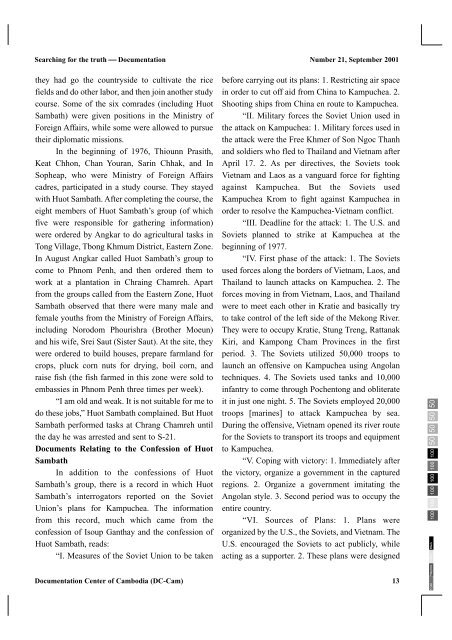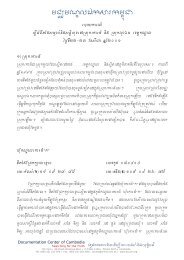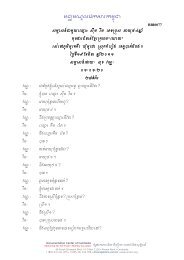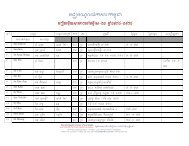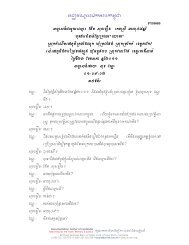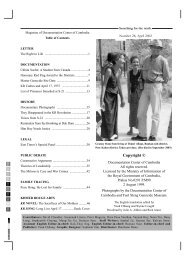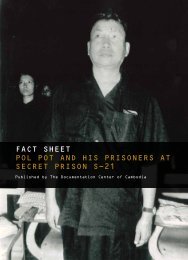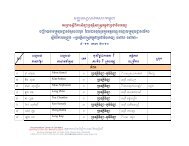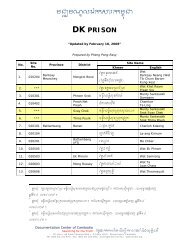Searching for the truth Issues 21 - Documentation Center of Cambodia
Searching for the truth Issues 21 - Documentation Center of Cambodia
Searching for the truth Issues 21 - Documentation Center of Cambodia
You also want an ePaper? Increase the reach of your titles
YUMPU automatically turns print PDFs into web optimized ePapers that Google loves.
<strong>Searching</strong> <strong>for</strong> <strong>the</strong> <strong>truth</strong> ⎯ <strong>Documentation</strong><br />
<strong>the</strong>y had go <strong>the</strong> countryside to cultivate <strong>the</strong> rice<br />
fields and do o<strong>the</strong>r labor, and <strong>the</strong>n join ano<strong>the</strong>r study<br />
course. Some <strong>of</strong> <strong>the</strong> six comrades (including Huot<br />
Sambath) were given positions in <strong>the</strong> Ministry <strong>of</strong><br />
Foreign Affairs, while some were allowed to pursue<br />
<strong>the</strong>ir diplomatic missions.<br />
In <strong>the</strong> beginning <strong>of</strong> 1976, Thiounn Prasith,<br />
Keat Chhon, Chan Youran, Sarin Chhak, and In<br />
Sopheap, who were Ministry <strong>of</strong> Foreign Affairs<br />
cadres, participated in a study course. They stayed<br />
with Huot Sambath. After completing <strong>the</strong> course, <strong>the</strong><br />
eight members <strong>of</strong> Huot Sambath’s group (<strong>of</strong> which<br />
five were responsible <strong>for</strong> ga<strong>the</strong>ring in<strong>for</strong>mation)<br />
were ordered by Angkar to do agricultural tasks in<br />
Tong Village, Tbong Khmum District, Eastern Zone.<br />
In August Angkar called Huot Sambath’s group to<br />
come to Phnom Penh, and <strong>the</strong>n ordered <strong>the</strong>m to<br />
work at a plantation in Chraing Chamreh. Apart<br />
from <strong>the</strong> groups called from <strong>the</strong> Eastern Zone, Huot<br />
Sambath observed that <strong>the</strong>re were many male and<br />
female youths from <strong>the</strong> Ministry <strong>of</strong> Foreign Affairs,<br />
including Norodom Phourishra (Bro<strong>the</strong>r Moeun)<br />
and his wife, Srei Saut (Sister Saut). At <strong>the</strong> site, <strong>the</strong>y<br />
were ordered to build houses, prepare farmland <strong>for</strong><br />
crops, pluck corn nuts <strong>for</strong> drying, boil corn, and<br />
raise fish (<strong>the</strong> fish farmed in this zone were sold to<br />
embassies in Phnom Penh three times per week).<br />
“I am old and weak. It is not suitable <strong>for</strong> me to<br />
do <strong>the</strong>se jobs,” Huot Sambath complained. But Huot<br />
Sambath per<strong>for</strong>med tasks at Chrang Chamreh until<br />
<strong>the</strong> day he was arrested and sent to S-<strong>21</strong>.<br />
Documents Relating to <strong>the</strong> Confession <strong>of</strong> Huot<br />
Sambath<br />
In addition to <strong>the</strong> confessions <strong>of</strong> Huot<br />
Sambath’s group, <strong>the</strong>re is a record in which Huot<br />
Sambath’s interrogators reported on <strong>the</strong> Soviet<br />
Union’s plans <strong>for</strong> Kampuchea. The in<strong>for</strong>mation<br />
from this record, much which came from <strong>the</strong><br />
confession <strong>of</strong> Isoup Ganthay and <strong>the</strong> confession <strong>of</strong><br />
Huot Sambath, reads:<br />
“I. Measures <strong>of</strong> <strong>the</strong> Soviet Union to be taken<br />
<strong>Documentation</strong> <strong>Center</strong> <strong>of</strong> <strong>Cambodia</strong> (DC-Cam)<br />
Number <strong>21</strong>, September 2001<br />
be<strong>for</strong>e carrying out its plans: 1. Restricting air space<br />
in order to cut <strong>of</strong>f aid from China to Kampuchea. 2.<br />
Shooting ships from China en route to Kampuchea.<br />
“II. Military <strong>for</strong>ces <strong>the</strong> Soviet Union used in<br />
<strong>the</strong> attack on Kampuchea: 1. Military <strong>for</strong>ces used in<br />
<strong>the</strong> attack were <strong>the</strong> Free Khmer <strong>of</strong> Son Ngoc Thanh<br />
and soldiers who fled to Thailand and Vietnam after<br />
April 17. 2. As per directives, <strong>the</strong> Soviets took<br />
Vietnam and Laos as a vanguard <strong>for</strong>ce <strong>for</strong> fighting<br />
against Kampuchea. But <strong>the</strong> Soviets used<br />
Kampuchea Krom to fight against Kampuchea in<br />
order to resolve <strong>the</strong> Kampuchea-Vietnam conflict.<br />
“III. Deadline <strong>for</strong> <strong>the</strong> attack: 1. The U.S. and<br />
Soviets planned to strike at Kampuchea at <strong>the</strong><br />
beginning <strong>of</strong> 1977.<br />
“IV. First phase <strong>of</strong> <strong>the</strong> attack: 1. The Soviets<br />
used <strong>for</strong>ces along <strong>the</strong> borders <strong>of</strong> Vietnam, Laos, and<br />
Thailand to launch attacks on Kampuchea. 2. The<br />
<strong>for</strong>ces moving in from Vietnam, Laos, and Thailand<br />
were to meet each o<strong>the</strong>r in Kratie and basically try<br />
to take control <strong>of</strong> <strong>the</strong> left side <strong>of</strong> <strong>the</strong> Mekong River.<br />
They were to occupy Kratie, Stung Treng, Rattanak<br />
Kiri, and Kampong Cham Provinces in <strong>the</strong> first<br />
period. 3. The Soviets utilized 50,000 troops to<br />
launch an <strong>of</strong>fensive on Kampuchea using Angolan<br />
techniques. 4. The Soviets used tanks and 10,000<br />
infantry to come through Pochentong and obliterate<br />
it in just one night. 5. The Soviets employed 20,000<br />
troops [marines] to attack Kampuchea by sea.<br />
During <strong>the</strong> <strong>of</strong>fensive, Vietnam opened its river route<br />
<strong>for</strong> <strong>the</strong> Soviets to transport its troops and equipment<br />
to Kampuchea.<br />
“V. Coping with victory: 1. Immediately after<br />
<strong>the</strong> victory, organize a government in <strong>the</strong> captured<br />
regions. 2. Organize a government imitating <strong>the</strong><br />
Angolan style. 3. Second period was to occupy <strong>the</strong><br />
entire country.<br />
“VI. Sources <strong>of</strong> Plans: 1. Plans were<br />
organized by <strong>the</strong> U.S., <strong>the</strong> Soviets, and Vietnam. The<br />
U.S. encouraged <strong>the</strong> Soviets to act publicly, while<br />
acting as a supporter. 2. These plans were designed<br />
13<br />
100 100 100 100 100 100 50 50 50 50<br />
Black<br />
Yellow<br />
Magenta<br />
Cyan


